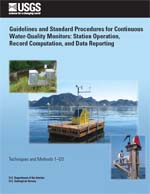Techniques and Methods 1—D3
| About USGS / Science Topics / Maps, Products & Publications / Education |
Supersedes Water-Resources Investigations Report 00-4252

This report provides basic guidelines and procedures for use by U.S. Geological Survey (USGS) personnel in site and water-quality monitor selection, field procedures, calibration of continuous water-quality monitors, record computation and review, and data reporting. Two techniques for servicing continuous monitors are discussed in this report: (1) a method for servicing monitors in a well-mixed, stable, or slowly changing aquatic environment; and (2) a method for servicing monitors in a dynamic, rapidly changing aquatic environment as is commonly found in estuaries. A discussion of alternative methods for servicing monitors also is included. These basic guidelines are minimal requirements that may need to be modified to meet local environmental conditions. Knowledge of the operation of the monitoring equipment and first-hand knowledge of the watershed form the core of the data evaluation process. Record-computation procedures presented in this report provide a uniform set of minimum requirements for computing records. Examples of the application of scientific judgment in the evaluation of data records are discussed and are, by necessity, site specific. Other specific examples also are included to demonstrate the range of environmental conditions that affect the evaluation process.
|
Table of Contents
Abstract
Introduction
Purpose and Scope
Acknowledgments
Water-Quality Monitoring Station Operation
Site Selection
Monitor Selection
Monitor Configurations and Sensors
Types of Sensors
Temperature
Specific Conductance
Salinity
Dissolved Oxygen
Percentage of Dissolved Oxygen Saturation
pH
Turbidity
Instrument Acceptance Criteria
Placement of Sensors in the Aquatic Environment
Stream Cross-Section Surveys
Lake or Estuary Vertical Profiles
Use and Calibration of Field Meters
Temperature
Specific Conductance
Dissolved Oxygen
pH
Turbidity
Monitor Operation and Maintenance
Standard Protocol
Maintenance
Sensor Inspection and Calibration Check
Steady-State Conditions
Rapidly Changing Conditions
Alternative Methods for Servicing a Monitor
Monitor Calibration Criteria
Field Cleaning of Sensors
Field Calibration of Sensors
Temperature Sensors
Specific Conductance Sensors
Dissolved Oxygen Sensors
pH Sensors
Turbidity Sensors
Troubleshooting Procedures
Requirements for Field Notes and Instrument Logs
Record Computation
Data-Processing Procedures
Initial Data Evaluation
Application of Data Corrections
Corrections for Fouling
Corrections for Calibration Drift
Other Corrections
Evaluation of Cross-Section Data Corrections
Computation of Salinity
Computation of Percentage of Dissolved Oxygen Saturation
Final Data Evaluation
Maximum Allowable Limits for Reporting Continuous Data
Publication Criteria
Preparation of the Review Package
Record Checking
Station Description
Station Analysis
Documentation
Level of Review Required
Contents of the Review Package
Data Reporting
Data Reports
Data-Qualification Statements
Reporting Parameter Codes and Units
Archiving of Records
Summary
References
Attachments
|